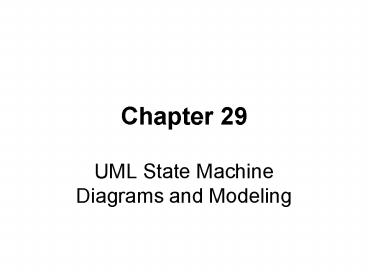UML State Machine Diagrams and Modeling - PowerPoint PPT Presentation
1 / 19
Title:
UML State Machine Diagrams and Modeling
Description:
Modeling State-dependent Objects. Complex reactive objects ... State Transition Model using State Pattern. Implementing transactional states: ... – PowerPoint PPT presentation
Number of Views:1267
Avg rating:3.0/5.0
Title: UML State Machine Diagrams and Modeling
1
Chapter 29
- UML State Machine Diagrams and Modeling
2
State Machine Diagram
- Illustrates the interesting events and states of
an object and the behavior of an object in
reaction to an event. - Event significant or noteworthy occurrence.
- E.g., telephone receiver taken off hook.
- State the condition of an object at a moment in
time (between events). - Transition a relationship between two states
when an event occurs, the object moves from the
current state to a related state.
3
UML State Machine Diagram
- States shown as rounded rectangles.
- Transitions shown as arrows.
- Events shown as labels on transition arrows.
- Initial pseudo-state automatically transitions to
a particular state on object instantiation. - Events with no corresponding transitions are
ignored.
4
Fig. 29.1 State machine diagram for a telephone
5
Transition Actions and Guards
- A transition can cause an action to fire.
- In software implementation, a method of the class
of the state machine is invoked. - A transition may have a conditional guard.
- The transition occurs only if the test passes.
6
Fig. 29.2 Transition action and guard notation
7
Nested States
- A state may be represented as nested substates.
- In UML, substates are shown by nesting them in a
superstate box. - A substate inherits the transitions of its
superstate. - Allows succinct state machine diagrams.
8
Fig. 29.3 Nested states
9
State-Independent vs. State-Dependent
- State-independent (modeless) type of object
that always responds the same way to an event. - State-dependent (modal) type of object that
reacts differently to events depending on its
state or mode. - Use state machine diagrams for modeling
state-dependent objects with complex behavior, or
to model legal sequences of operations.
10
Modeling State-dependent Objects
- Complex reactive objects
- Physical devices controlled by software
- E.g., phone, microwave oven, thermostat
- Transactions and related business objects
- Protocols and legal sequences
- Communication protocols (e.g., TCP)
- UI page/window flow or navigation
- UI flow controllers or sessions
- Use case system operations
11
Fig. 29.4 Web page navigation modeling
12
Fig. 29.5 Legal sequence of use case operations
13
GoF State Pattern
- Problem
- An objects behavior is dependent on its state,
and its methods contain case logic reflecting
conditional state-dependent actions. - Solution
- Create a state class for each state, implementing
a common interface. - Delegate state-dependent operations from the
context object to its current state object. - Ensure context object always points to a state
object reflecting its current state.
14
Example Transactional States
- A transactional support system typically keeps
track of the state of each persistent object. - Modifying a persistent object does not cause an
immediate database update an explicit commit
operation must be performed. - A delete or save causes change of state, not an
immediate database delete or save. - A commit operation updates the database if an
object was modified (dirty), but does nothing
if the object is clean.
15
Fig. 38.12 Statechart for PersistentObject
16
Fig. 38.13 Persistent Objects
- Assume all persistent object classes extend a
PersistentObject class that provides common
technical services for persistence.
17
Case-logic Structure
- Using case logic, commit and rollback methods
perform different actions, but have a similar
logic structure. - public void commit()
- switch ( state )
- case OLD_DIRTY
- // . . .
- break
- case OLD_CLEAN
- // . . .
- break
- . . .
18
State Transition Model using State Pattern
- Implementing transactional states
- Create static singleton objects for each state
that are specializations of PObjectState. - The commit method is implemented differently in
each state object. - PersistentObject is the context object.
- Keeps a reference to a state object representing
the current state. - Methods in the state objects call setState() to
cause a transistion to the next state. - No case logic is needed.
19
(No Transcript)































